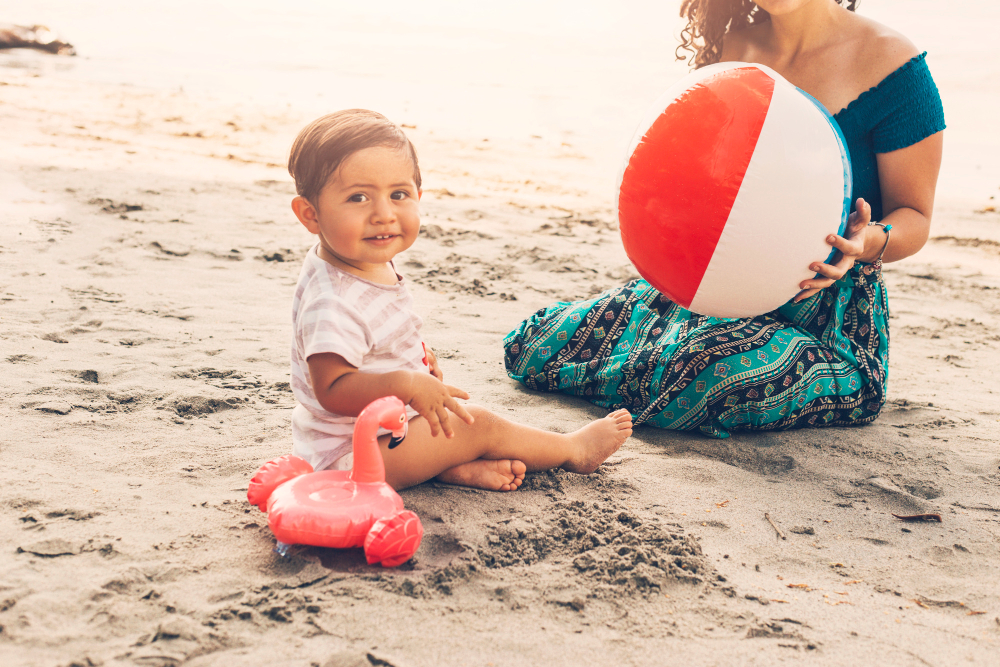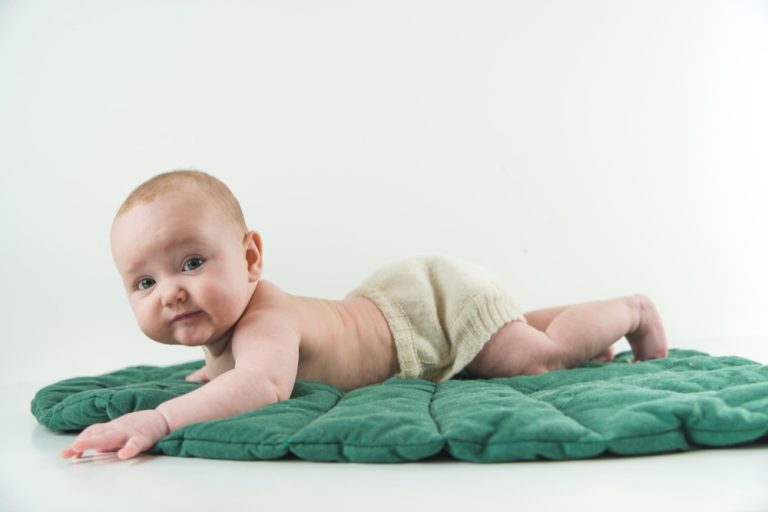When Can Babies Go To The Beach? Baby Beach Hacks
Are you ready to create treasured memories with your little one at the beach but feeling overwhelmed with questions and concerns? Do you wonder when can babies go to the beach? Taking a baby to the beach requires meticulous planning and thoughtful preparation to ensure a safe and enjoyable experience.
From sun protection to entertainment, we’ve got you covered with everything you need to know before undertaking this adventure.
Get ready to soak up the sun responsibly and create unforgettable beach memories with your little beachcomber. Let’s dive into the “when can babies go to the beach” guide that will ensure your baby’s first beach trip is a breeze.
Introduction to Taking Babies to the Beach
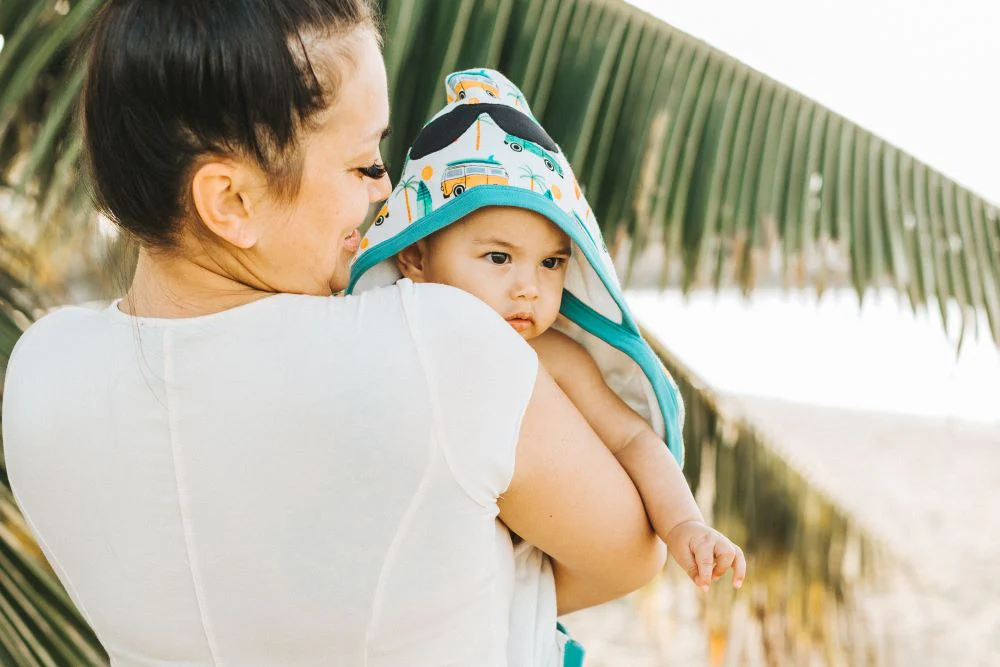
Bringing your baby to the beach can be an exciting and enriching experience for both parents and little ones. The beach offers a unique environment that stimulates your baby’s senses and provides an opportunity for sensory exploration. Not only does it allow them to have fun and enjoy the outdoors, but it also contributes to their cognitive, physical, and emotional development.
Spending time at the beach exposes babies to various sensations, such as the feeling of sand between their toes, the sound of crashing waves, and the sight of seagulls soaring above. These multisensory experiences can help promote their sensory integration skills and enhance their ability to process and respond to different stimuli.
Additionally, the beach offers ample opportunities for physical activity. Crawling or walking on the sand helps strengthen their muscles and develop their gross motor skills. Playing with beach toys like shovels and buckets encourages fine motor skills development and hand-eye coordination.
Moreover, spending time in nature, especially in the presence of water and green spaces, has been linked to numerous health benefits for both children and adults. Research has shown that being in natural environments can improve mood, reduce stress levels, and enhance overall well-being.
While it’s essential to nurture your baby’s development, safety and comfort should always be top priorities when taking them to the beach. In the following sections, we will delve deeper into age-appropriate considerations, safety tips, and practical advice to ensure a safe and enjoyable beach experience for your little one.
Remember, by introducing your baby to the beach early on, you’re not only creating lasting memories but also providing them with opportunities for growth, learning, and exploration.
When Can Babies Go To The Beach?
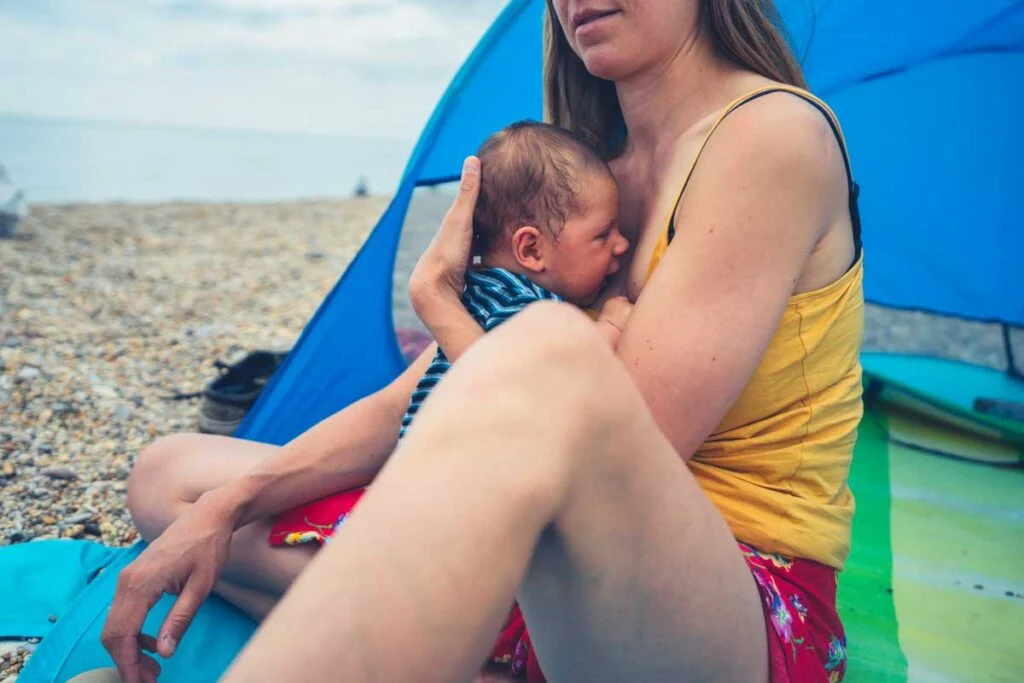
Taking babies to the beach can be a delightful experience, but it’s crucial to consider their age and developmental readiness. The appropriate age for a beach outing with a baby depends on several factors.
Here are some important considerations to keep in mind:
1. Sun Exposure and Safety Precautions
Newborn babies have delicate skin that is highly sensitive to the sun’s harmful rays. Experts recommend avoiding direct sunlight exposure for babies younger than six months. Their thin skin lacks sufficient melanin production, making them more susceptible to sunburn and heat-related issues.
- When considering a beach trip for babies older than six months, ensure you take appropriate safety measures.
- Use a baby-friendly sunscreen with a high SPF, protective clothing, and a wide-brimmed hat to shield them from the sun.
- Seek shade whenever possible, especially during peak sun hours.
2. Ability to Handle Different Environments
Babies develop at different rates, and their ability to handle external environments varies. Assess your baby’s responsiveness to new stimuli, such as sand texture, sounds, and temperature changes. It’s important to remember that babies explore the world through their senses, and an overwhelming environment may cause distress.
- Before venturing to the beach, gradually introduce your baby to different textures at home, such as a small sand tray or a sensory play activity.
- This helps gauge their comfort level and ensures a smoother transition when they encounter the beach for the first time.
3. Consider Local Water Advisory
If your beach destination includes water activities, it’s essential to consider local water advisories. Look for signs specifying any potential contaminants or unsafe water conditions. The American Academy of Pediatrics advises against exposing young babies to untreated or potentially polluted water, as it can lead to serious health risks.
- Always prioritize your baby’s well-being and consult the appropriate authorities if you have concerns about the beach’s water quality or safety.
Remember, each baby is unique, and age should not be the sole determinant for taking them to the beach. Observe your baby’s cues, consult with your pediatrician, and use your discretion when deciding if they are ready for this new experience.
Best Time of Day to Take Babies to the Beach
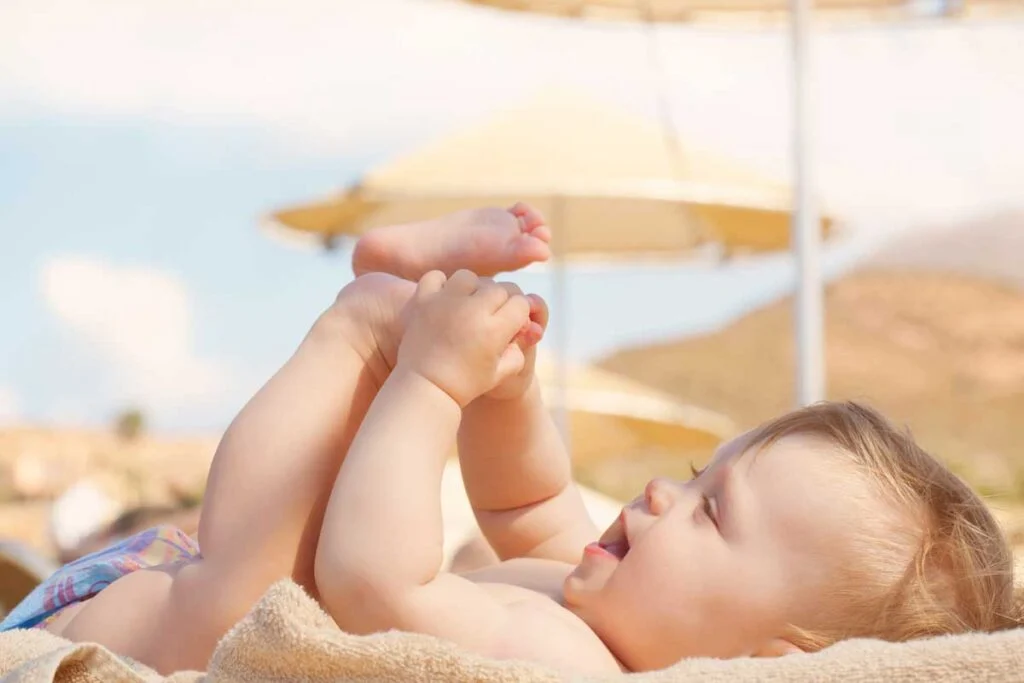
When it comes to taking babies to the beach, timing is everything. Choosing the right time of day can make a significant difference in your little one’s comfort and safety. Here are some factors to consider when planning your beach outing with your baby:
Temperature
- Opt for cooler times of the day, such as early mornings or late afternoons, when the sun is less intense.
- This helps prevent your baby from overheating and reduces the risk of sunburn.
- Remember, babies are more sensitive to heat and can quickly become uncomfortable in hot weather.
Sun Exposure
- Avoid peak hours of sun exposure, usually between 10 a.m. and 4 p.m. during the summer months.
- Ultraviolet (UV) rays are strongest during this time, increasing the risk of sunburn and heat-related issues.
- By going to the beach outside of these hours, you can minimize your baby’s exposure to harmful rays.
General Beach Crowd
- Consider visiting the beach during off-peak hours when it’s less crowded.
- This allows you and your baby to enjoy a calmer and more relaxed experience.
- Fewer people also mean less noise and distractions, creating a peaceful environment for your little one.
Remember, every baby is different, and their tolerance for heat and sun exposure varies. Pay attention to your baby’s cues and adjust your beach visit accordingly. By choosing the right time of day, you can make your baby’s beach experience enjoyable and safe.
Duration of Beach Visits for Babies
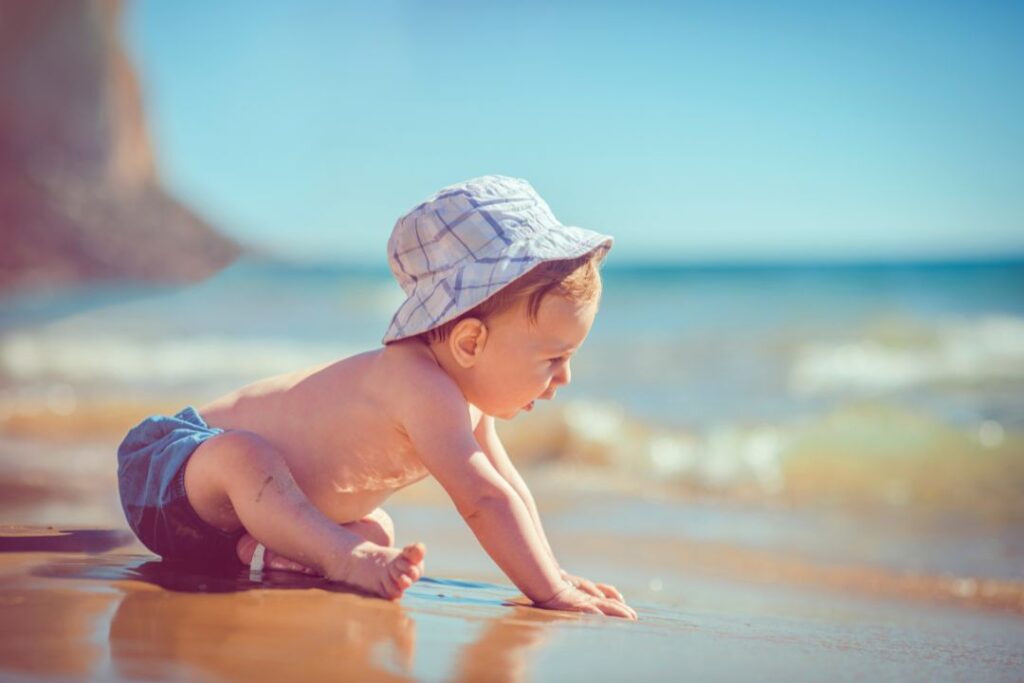
When planning a beach trip with your baby, it’s important to consider the duration of your visit to ensure their safety, comfort, and enjoyment. Here are some recommendations for the ideal length of beach visits with babies:
1. Take Frequent Breaks
- Babies have limited tolerance for sun, heat, and stimulation, so it’s crucial to take frequent breaks during your beach outing.
- Find a shaded area away from direct sunlight where your baby can rest and cool down.
- Use this time to change diapers, feed, and provide necessary comfort to your little one.
2. Limit Exposure to Sun and Heat
- The American Academy of Pediatrics recommends keeping babies under 6 months old completely out of direct sunlight.
- For older babies, limit their exposure to the sun’s rays by seeking shade, using sunscreen, and dressing them in lightweight, breathable clothing.
- Monitor your baby closely for signs of overheating and take necessary precautions to prevent heat-related issues.
3. Consider Your Baby’s Needs
- Every baby is different, and their tolerance for the beach environment can vary.
- Pay attention to your baby’s cues and well-being throughout the visit.
- If your baby becomes fussy, overwhelmed, or tired, it may be time to cut the beach trip short and head home for comfort and safety.
Remember, the duration of beach visits for babies should be based on their individual needs and well-being. Always prioritize their comfort, provide sufficient breaks, and ensure they remain hydrated and protected from the sun.
How to Prepare for a Beach Trip with a Baby: A Guide
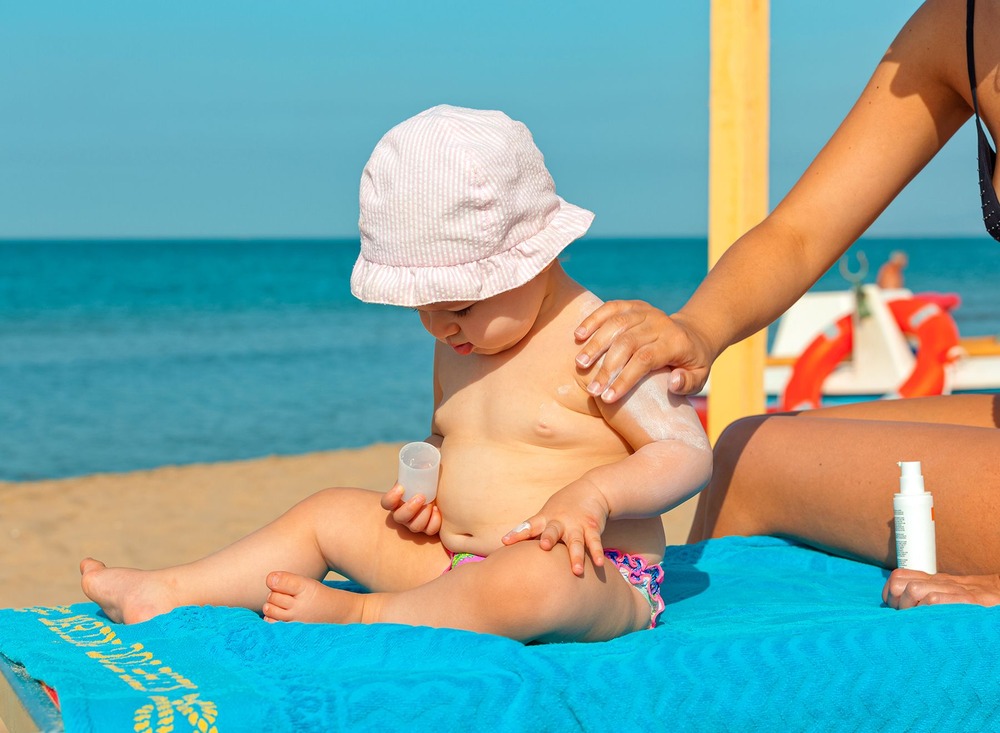
Taking a baby to the beach requires careful planning and preparation to ensure their safety and comfort. Here’s a comprehensive guide on what parents should bring and prepare for when venturing on a beach trip with their little ones.
1. Sun Protection Essentials
- Pack a wide-brimmed hat and sunglasses to shield your baby’s delicate skin and eyes from the sun’s harmful rays.
- Apply a broad-spectrum sunscreen with an SPF of at least 30 to protect their exposed skin.
- Reapply every two hours or after swimming.
2. Beach Gear
- Choose a lightweight and breathable baby carrier or stroller that can navigate sandy terrain.
- Ensure it provides proper support and comfort for the baby.
- Pack a beach tent or umbrella to create a shaded area for your baby to rest and play.
- Carry a sand-free play mat or blanket to keep your baby clean and comfortable while enjoying the beach.
3. Clothing and Accessories
- Dress your baby in lightweight, loose-fitting clothing made from breathable materials to prevent overheating.
- Opt for swim diapers or reusable swim nappies to contain any accidents when your baby is in the water.
- Consider using a rash guard or UV-protective swimsuit to provide added sun protection.
4. Feeding and Hydration
- Bring plenty of water and fluids so both you and your baby can stay hydrated throughout the day.
- If you’re formula feeding, consider pre-measured cartons of ready-made formula milk for easy preparation.
- Pack snacks and finger foods suitable for your baby’s age and dietary needs.
5. Beach Safety Essentials
- A first aid kit with items such as band-aids, antiseptic wipes, and baby-safe insect repellent is a must-have for any beach trip.
- Stay vigilant and keep a close eye on your baby at all times.
- Avoid placing them near the water’s edge, and be aware of potential dangers.
6. Entertainment and Comfort
- Bring beach toys, such as a bucket and spade, or sandcastle molds to keep your baby entertained and engaged in sensory play.
- Don’t forget their favorite comfort items, such as a blanket or stuffed toy, to provide a sense of familiarity in a new environment.
By following these essential tips and packing the necessary items, you’ll be well-prepared for a memorable and enjoyable beach trip with your baby. Remember to prioritize their safety, comfort, and overall well-being throughout the day.
Baby Beach Hacks and Safety Tips
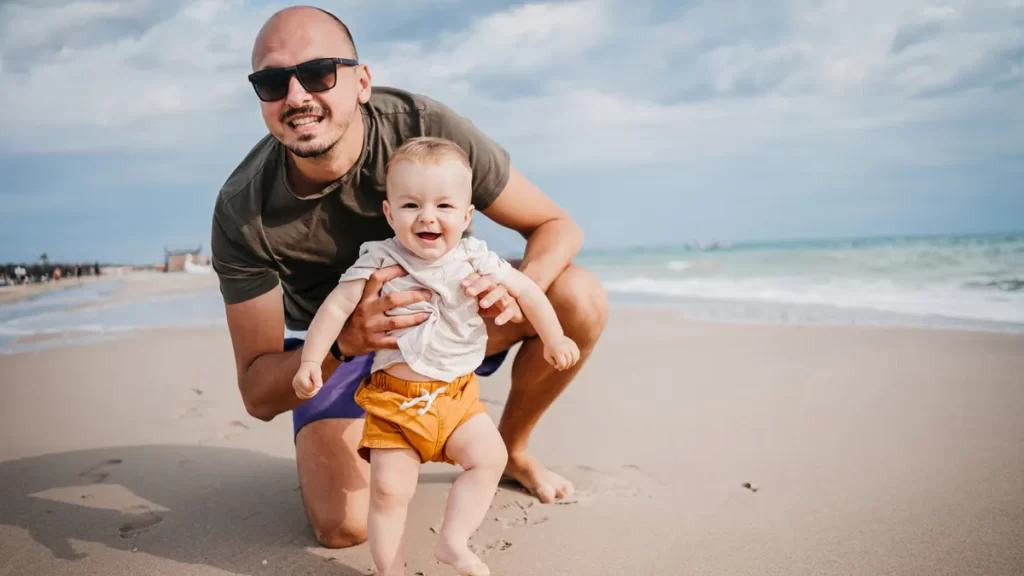
When taking your baby to the beach, it’s crucial to prioritize their safety and comfort. Here are some practical baby beach hacks and safety tips to ensure a safe and enjoyable experience for both babies and parents.
Sun Protection
- Apply sunscreen with a high SPF specifically designed for babies, at least 15-30 minutes before going to the beach.
- Dress your baby in lightweight, long-sleeved clothing and a wide-brimmed hat to protect their delicate skin from the sun.
- Set up a beach umbrella or shade tent to create a shaded area for your baby to play and rest.
Staying Cool
- Avoid direct sunlight during peak hours, typically from 10 am to 4 pm, to prevent heat-related issues.
- Use a portable fan or misting bottle to keep your baby cool when temperatures rise.
- Bring a small inflatable pool filled with shallow water for your baby to splash and cool off in.
Creating a Sand-Free Play Area
- Lay a large beach towel or blanket on the sand, providing a clean and comfortable area for your baby to play.
- Use a fitted sheet with the corners weighed down by beach bags or toys to create a sand-free playpen.
- Bring baby powder to sprinkle on your baby’s skin before brushing off the sand easily.
Water Safety
- Always keep a close eye on your baby around water, even in shallow areas.
- Use a properly fitted swim diaper or reusable swim nappy to prevent accidents.
- Teach your baby to float or use floatation devices approved for their age and size.
Safety Measures
- Keep a fully stocked first aid kit handy, including band-aids, antiseptic wipes, and any necessary medication.
- Bring a baby-friendly insect repellent to protect your baby from bug bites.
- Stay aware of beach warnings, such as local water advisories or jellyfish sightings, and follow any necessary precautions.
Remember, each baby is unique, and it may take a bit of trial and error to find the best approach for your little one. By implementing these baby beach hacks and safety tips, you can create a safe and enjoyable environment for your baby while enjoying the sun, sand, and surf.
Feeding and Napping at the Beach
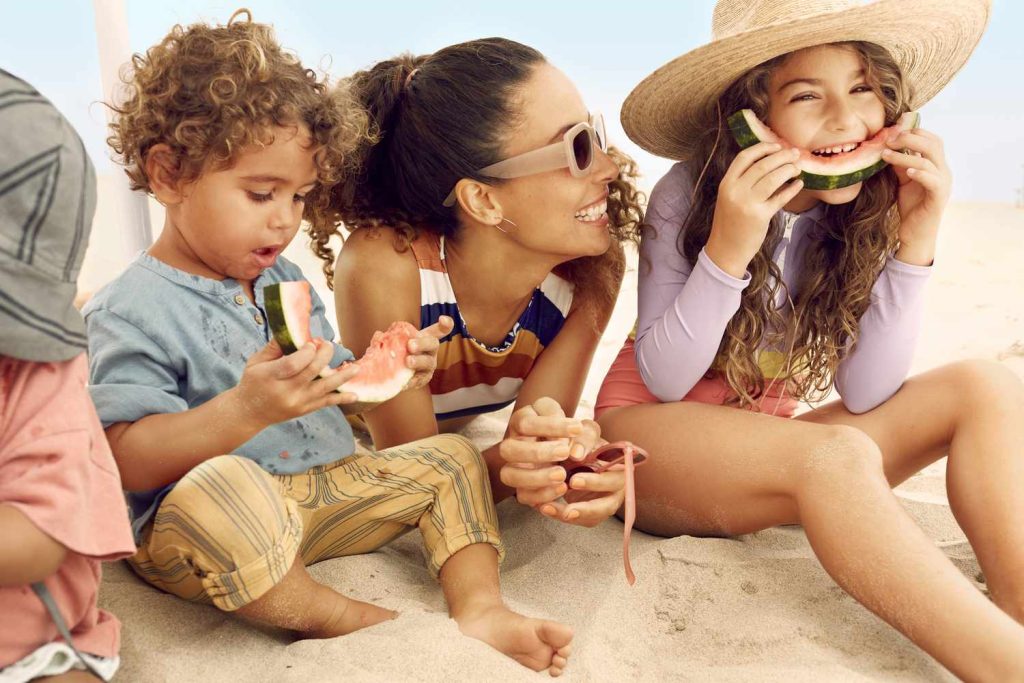
When taking your baby to the beach, it’s important to consider their feeding and napping routines to ensure they remain comfortable and content throughout your outing.
Here are some essential tips to help you navigate feeding and napping at the beach:
Maintaining a Schedule
- Try to stick to your baby’s regular feeding and nap schedule as much as possible.
- Keeping a consistent routine can provide a sense of familiarity and comfort for your little one, even in a different environment like the beach.
- Plan your beach visit around your baby’s usual feeding and nap times, ensuring they have the opportunity to eat and rest as needed.
Creating a Comfortable Environment
- Make sure to bring a portable and lightweight baby carrier or stroller that can provide a safe and comfortable space for your baby to nap.
- Opt for a carrier or stroller with breathable fabric to prevent overheating.
- You can also create a cozy spot for your baby to rest by laying a soft, lightweight blanket or towel in the shade.
- This will protect them from direct sunlight and provide a comfortable space for napping.
Timing Feedings
- If your baby is exclusively breastfed, finding a secluded spot on the beach away from distractions can help your baby stay focused during feedings.
- If you’re formula feeding, consider pre-measuring the formula into individual cartons or using ready-made formula bottles for convenience.
Hydration and Snacks
- Keep your baby hydrated by offering small sips of water or breast milk throughout the day.
- However, be cautious about sand getting into their drinks, so it’s best to use spill-proof containers.
- If your baby has started solids, pack some easy-to-eat snacks such as sliced fruits or baby-friendly snacks.
- This keeps them satisfied and prevents hunger-related discomfort.
Protecting from Distractions
- To eliminate distractions and create a calming environment for napping, consider using a white noise machine or playing soothing sounds through a portable speaker.
- This can help drown out any noisy beach activities and provide consistent background noise to aid your baby’s sleep.
Remember to monitor your baby’s cues and adjust their feeding and napping routines as needed. Every baby is different, so it’s essential to adapt to their individual needs and preferences. With proper planning and attention to your baby’s needs, you can ensure they have a comfortable and peaceful beach experience.
The Final Note: When Can Babies Go To The Beach
So, to answer when can babies go to the beach in a nutshell, taking your baby to the beach can be a wonderful and enriching experience for both you and your little one. It provides opportunities for sensory exploration, physical activity, and exposure to nature, contributing to their overall development and well-being.
When planning a beach trip with your baby, always prioritize safety, sun protection, and their developmental readiness. By being mindful of their unique needs and consulting with your pediatrician when necessary, you can create beautiful and lasting beach memories while ensuring a safe and enjoyable experience for your baby.
So, get ready to soak up the sun responsibly and make unforgettable beach memories with your little beachcomber!
FAQs: When Can Babies Go To The Beach
Remember, every baby is unique, and it’s important to consider their individual needs when planning a beach trip. By following these guidelines and using common sense, you can create a safe and enjoyable beach experience for your little one.

